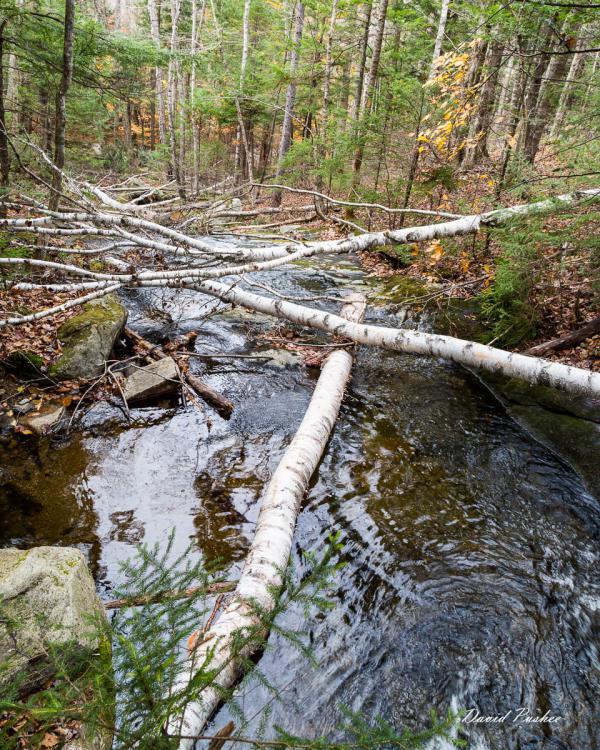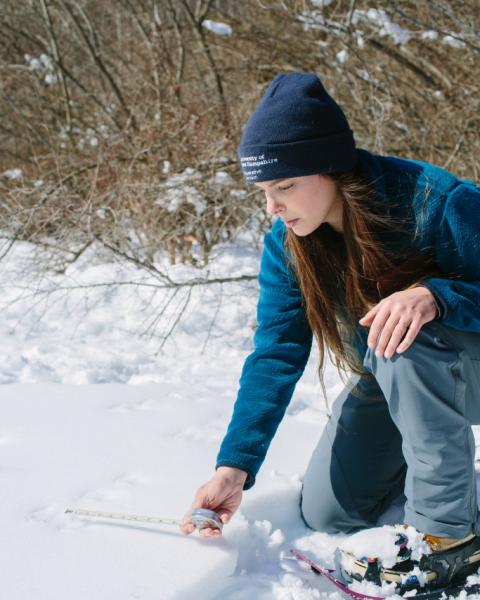Brook Trout are a native freshwater fish found in streams, rivers, ponds, and lakes throughout New Hampshire. They are powerful swimmers often found in steep, cascading mountain streams.
Brook Trout have a long, streamlined body with a large mouth that extends past the eye. Their color can vary greatly, depending on their habitat. The lower sides of a Brook Trout can vary between red (usually males during spawning), silver, black, green, or brown, while their underbelly ranges from pink, red, orange to yellow.
They also have yellow and red spots surrounded by blue circles on their sides. Their backs are usually olive to dark green in color with black wave-like markings called vermiculations. Their bottom fins have distinct white borders on the outer edges. The species has a slight or very shallow forked tail. Brook Trout rarely exceed ten inches in the wild in New Hampshire.
Did you know..?
- New Hampshire’s state record Brook Trout was 9 pounds, 25.5 inches.
- The presence of a healthy Brook Trout population is a sign of a healthy stream with good water quality.
Habitat
Brook Trout can inhabit ponds and lakes, but are more common in small to medium-sized rivers and streams in New Hampshire. Brook Trout depend on clean, coldwater habitats with high dissolved oxygen levels. They’re rarely found in waters where summer temperatures are higher than 70º F for long periods of time.
Brook Trout require a variety of different habitat types within rivers and streams, and their preferences can change based on the age or size of the fish, as well as the time of year. Generally, a cooler river or stream with a mixture of pools, riffles, and runs that includes undercut banks and fallen trees will support wild Brook Trout.
During spawning, Brook Trout use gravel beds with upwelling groundwater. These areas are often in tributaries that do not completely freeze during the winter. Females excavate a nest, called a redd. Eggs are laid in the redd and are simultaneously fertilized by males. The eggs incubate in the gravel through winter and hatch in early spring. Though some individuals may live their entire lives in one small stream, radio-tagged Brook Trout have moved over 50-miles throughout the year in search of ideal habitat and foraging areas.
Buffers Have Benefits
Brook Trout and other aquatic organisms benefit from well-established riparian buffers. These vegetated areas adjacent to rivers and streams keep the stream shaded and cooled, filter pollutants, provide food in the form of terrestrial insects, and allow trees to naturally fall into the stream, all of which enhances the habitat.
Species Status and Distribution
Brook Trout are more common in the northern part of the state, where inherently cooler air temperatures and forested landscapes help maintain colder water throughout the summer. In southern New Hampshire, Brook Trout are dependent on groundwater-influenced streams, a source of cool water in the summer.
Threats to Brook Trout
Land use changes. Over the past several hundred years, land use decisions and human development have severely reduced the quality of Brook Trout habitat in New Hampshire. Rivers and streams have been straightened for flood control, log drives, and to protect streamside development. These events have altered the natural features of a stream that are important to Brook Trout—meandering bends, undercut banks, and large wood recruitment. Development and road construction near streams can result in increased sedimentation that can smother Brook Trout eggs and aquatic insects that fish eat, as well as increased nutrient loading from road and lawn runoff. Stream temperatures can become too warm to support Brook Trout in areas devoid of trees and other streamside vegetation.
Fragmentation from dams and culverts. Dams and inappropriately designed stream crossings can act as barriers to movement for Brook Trout and other aquatic organisms. Streams that become fragmented isolate populations, reduce genetic diversity, and limit access to spawning habitat and areas that have cooler temperatures. Dams also increase water temperatures by reducing surface flow and increasing solar radiation. Undersized stream crossings cause streambed scouring and bank erosion, which eventually leaves the crossing “perched” above the water surface.
Introduced species. Warmwater species, such as Smallmouth Bass, and other invasive species released into rivers and streams may impact wild Brook Trout populations by eating them or forcing them out of high quality habitat.
Acid deposition. Acid deposition in the form of rain and snow has reduced or eliminated populations of Brook Trout and other fish species in the northeast, especially in naturally acidic, high elevation small streams and ponds.
How You Can Help
Minimize your impact. Make fish-friendly land use decisions on your Focus on Wildlife property. Timber harvesting around streams and rivers should leave enough shade and large trees to maintain temperatures, filter runoff, and allow for woody material like dead and dying trees, leaves, and branches to naturally fall into streams. Keep building structures away from the floodplain, and maintain pervious (permeable) surfaces on as much of the landscape as possible to prevent sediments and runoff from entering the stream.

Maintain or enhance existing habitat. Promote land use practices which encourage the natural recruitment of in-stream wood and tree growth within riparian corridors. Maintain streamside vegetation, or plant trees and shrubs to preserve or restore a healthy riparian buffer. With guidance from NH Fish and Game and Trout Unlimited, determine if a stream is eligible for habitat enhancement projects such as in-stream wood additions. These types of projects require detailed planning and permitting.
Remove dams and improve stream crossings. Dam removal and stream crossing restoration, by individual landowners and communities, can restore the natural flow of a river or stream. Removal should target dams or stream crossings that fragment critical habitats necessary for Brook Trout or those that significantly warm stream temperatures. Improve or replace inadequate stream crossings— properly designed and installed stream crossings are critical for restoring or maintaining healthy stream habitat and migratory pathways, and they are more resilient to floods.
Conserve your land. Protecting rivers, streams, and headwaters from development will allow for the natural processes that provide food and habitat for Brook Trout. Maintaining intact, undeveloped headwaters will help stabilize temperatures and may also buffer predicted higher temperatures and increased flooding associated with climate change.
New Hampshire remains a stronghold for Brook Trout in the Eastern United States, and still contains large expanses of relatively intact habitat— especially in northern New Hampshire. But even here, populations are declining. Historical records suggest that both the number and size of wild Brook Trout have declined.
Additional Information
For more information on Brook Trout contact your regional Inland Fisheries Biologist, or visit: www.fishnh.com/fishing/wild-brook-trout.html
For information about regional Brook Trout conservation efforts, visit: www.easternbrooktrout.org
For information about regulations related to dam removal, stream crossings, and adding wood to streams, call the NH Fish and Game Fish Habitat Biologist at (603) 271-2744, or visit the Department of Environmental Services at: www.des.nh.gov

We bring information about NH’s wildlife to you! The Taking Action for Wildlife Team, made up of staff from both NH Fish and Game and UNH Cooperative Extension, works to help towns, land trusts, natural resource professionals, and private landowners conserve wildlife and habitats in New Hampshire. We help put information from NH’s Wildlife Action Plan in the hands of New Hampshire citizens.
For more information about habitat management, resources and publications about other wildlife, and to learn more about the New Hampshire Wildlife Action Plan visit www.takingactionforwildlife.org
Download Resource for printable version
------------------------------------------------------------------------------
This webpage and accompanying Focus on Wildlife brochure was developed by UNH Cooperative Extension and NH Fish & Game. Written by Haley Andreozzi, Matthew Carpenter, Dianne Timmins, and Benjamin Nugent. May 2017.
Photo Credits: NH Fish and Game Department; David Pushee
